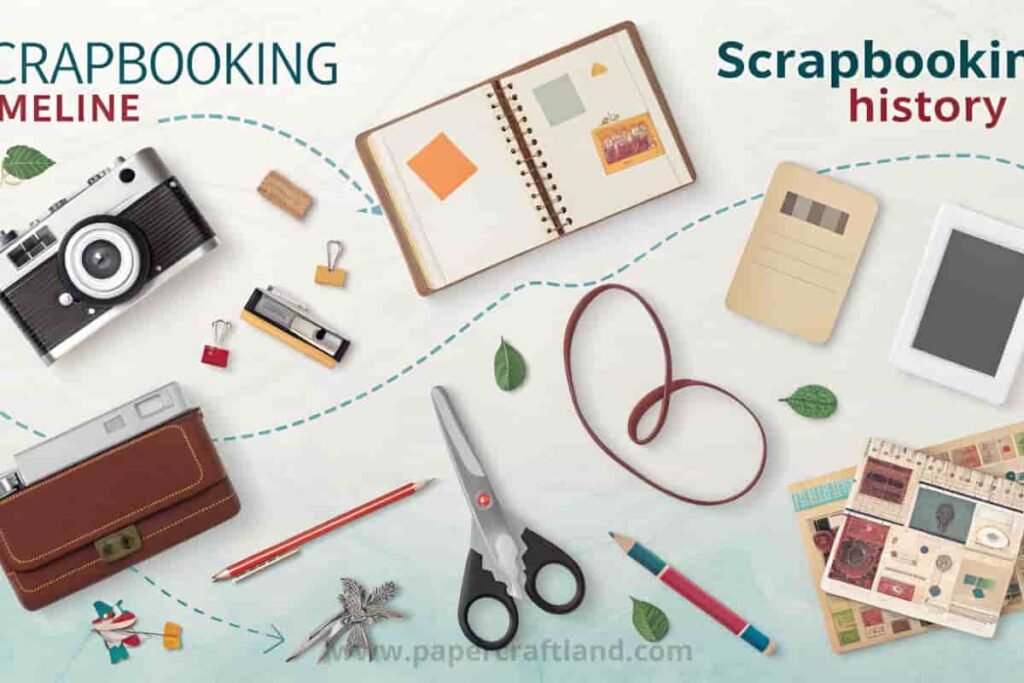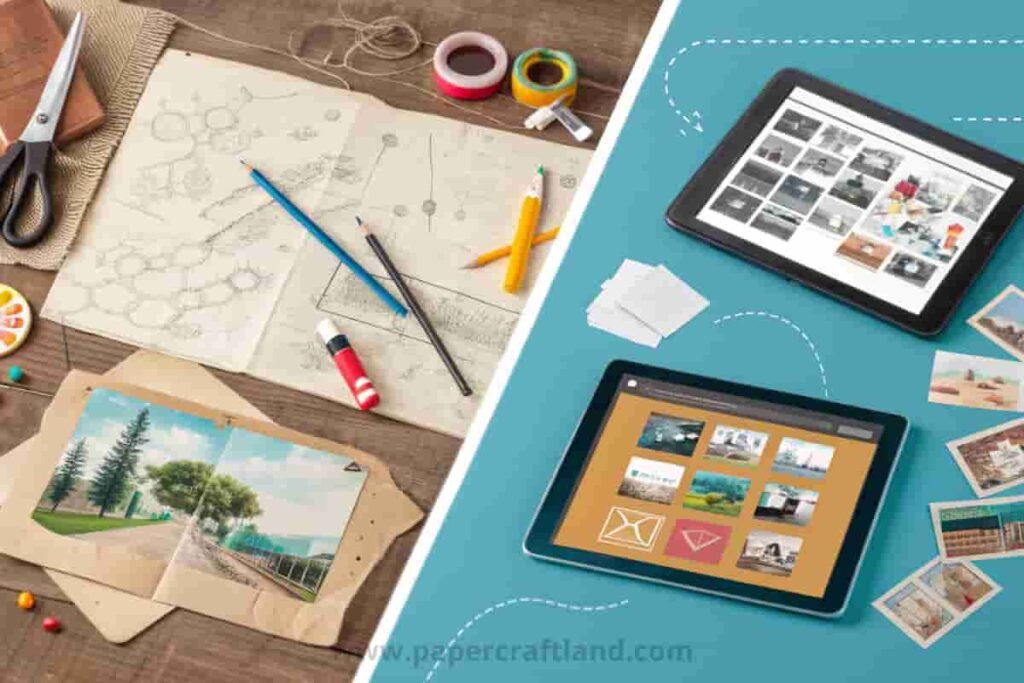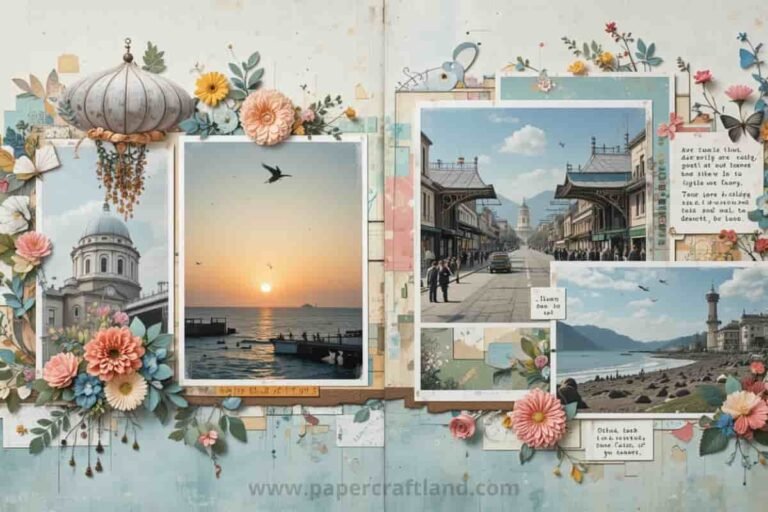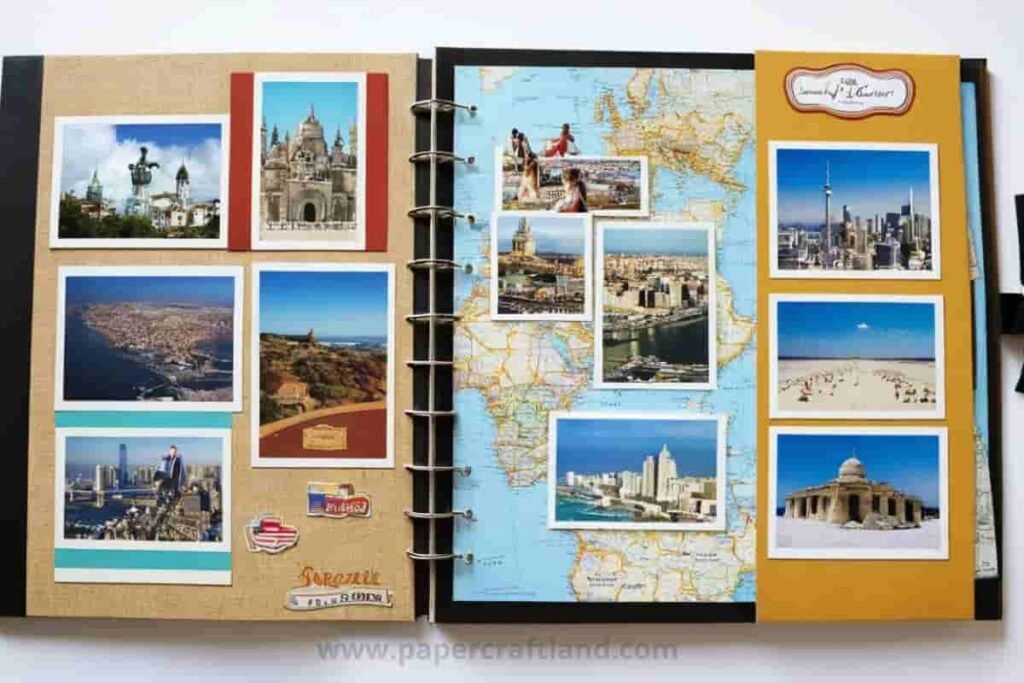Introduction to Scrapbooking
Scrapbook Layout Design is more than just a hobby; it’s a beautiful way to preserve memories, express creativity, and tell personal stories through a blend of photographs, journaling, and decorative elements.
Whether it’s capturing the joy of a family vacation, the milestones of a child’s growth, or the quiet moments of everyday life, scrapbooking allows us to document and cherish our most treasured experiences.
- Introduction to Scrapbooking
- What is Scrapbooking?
- The Evolution of Scrapbooking
- Why Scrapbooking is Popular Today
- Basics of Scrapbook Layout Design
- Principles of Scrapbook Layout Design
- Different Types of Scrapbook Layouts
- Minimalist vs. Maximalist Designs
- Techniques for Creating Stunning Scrapbook Layouts
- Tools and Materials for Scrapbook Layout Design
- Tips for Enhancing Your Scrapbook Layouts
- Scrapbooking as a Therapeutic Hobby
- The Future of Scrapbook Layout Design
- Conclusion
- FAQs
What is Scrapbooking?
Scrapbooking involves creating decorated pages that feature photos, mementos, and embellishments, arranged in a visually pleasing layout. Each page or “layout” tells a story, capturing moments and memories in a personalized and artistic way.
While traditional scrapbooking is done with physical materials like paper, scissors, and glue, digital scrapbooking has also gained popularity, allowing for creative designs using software tools.
The Evolution of Scrapbooking

The roots of scrapbooking date back to the 15th century when people would collect handwritten notes, poems, and mementos in books. By the 1800s, scrapbooks became more popular, incorporating photographs as technology advanced.
The modern era of scrapbooking began in the 1980s, with the introduction of dedicated scrapbooking stores and a wider range of decorative supplies. Today, scrapbooking is a global phenomenon, fueled by online communities, workshops, and endless inspiration.
Why Scrapbooking is Popular Today
Scrapbooking’s popularity can be attributed to its ability to combine creativity with personal storytelling. It offers a tactile and fulfilling experience, a break from the digital world, and a way to connect with memories in a tangible form.
The rise of social media platforms like Pinterest and Instagram has also helped scrapbooking thrive, allowing enthusiasts to share their layouts and inspire others.
Basics of Scrapbook Layout Design

Key Elements of a Good Scrapbook Layout
A successful scrapbook layout typically includes photos, journaling, and embellishments arranged in a balanced and harmonious way. Photos are the focal point, telling the main story of the page.
Journaling adds context, emotions, or details about the photos, making the layout more personal. Embellishments, such as stickers, die-cuts, and washi tape, enhance the visual appeal and help tie the theme together.
Understanding Layout Anatomy: Photos, Journaling, and Embellishments
- Photos: Select high-quality photos that best represent the theme of your layout. Crop and edit them if needed to fit your design.
- Journaling: Use journaling to add narrative to your photos. This can be a few words, a detailed story, or even quotes and song lyrics that capture the moment.
- Embellishments: Choose embellishments that complement your theme without overwhelming the photos. Balance is key to ensure that the focus remains on your pictures.
Common Scrapbook Sizes and Their Uses
Scrapbooks come in various sizes, each serving different purposes. Common sizes include:
- 12×12 inches: The most popular size, offering ample space for photos and creative layouts.
- 8×8 inches: Great for smaller projects or themed albums, such as vacations or weddings.
- 6×6 inches: Ideal for mini-albums, quick projects, or gifts.
- Traveler’s Notebooks: A portable option for journaling and scrapbooking on the go.
Principles of Scrapbook Layout Design
Balance and Symmetry
Balance is crucial in scrapbook layout design, ensuring that elements are distributed evenly across the page. Symmetrical layouts have equal visual weight on both sides, creating a harmonious and orderly feel.
Asymmetrical layouts can also be balanced, using contrasting elements of varying sizes and shapes to create dynamic and visually engaging designs.
Focal Points and Visual Hierarchy
Every scrapbook layout should have a clear focal point, usually the main photo or group of photos. Visual hierarchy guides the viewer’s eye through the layout, from the focal point to supporting elements like journaling and embellishments.
Use size, color, and placement to establish hierarchy, making sure that the most important elements stand out.
Color Theory in Scrapbooking
Color plays a significant role in setting the tone and mood of a scrapbook layout. Understanding basic color theory can help you create harmonious designs.
Complementary colors (opposites on the color wheel) create vibrant contrast, while analogous colors (next to each other on the wheel) offer a more cohesive and calming effect. Neutrals can be used to balance bold colors and provide visual rest.
Use of White Space and Composition
White space, or negative space, refers to the empty area surrounding the elements in your layout. It helps prevent your design from feeling cluttered and gives the viewer’s eye a place to rest.
Effective use of white space enhances composition, making your layout look clean, modern, and intentional. It’s not just about the elements you add, but also about the space you leave empty.
Different Types of Scrapbook Layouts

Single-Photo Layouts
Single-photo layouts focus on one main image, making it the star of the page. These layouts are great for highlighting special moments or particularly striking photos.
With only one photo to focus on, you have more space for creative embellishments, journaling, and artistic touches.
Multi-Photo Layouts
Multi-photo layouts are perfect for telling a story or capturing an event with several images. The challenge is to keep the layout organized and visually balanced.
Use grids, overlapping photos, or staggered placements to arrange multiple images without overwhelming the page.
Thematic Layouts (Holidays, Birthdays, Travel, etc.)
Thematic layouts revolve around specific events or themes, such as holidays, birthdays, or travel. These layouts allow you to incorporate themed embellishments, like Christmas stickers or tropical papers, to reinforce the mood and subject of your photos.
The key is to keep the theme cohesive while maintaining focus on the photos.
Minimalist vs. Maximalist Designs
- Minimalist Layouts: These designs embrace simplicity, with clean lines, lots of white space, and limited embellishments. They emphasize photos and journaling, allowing the story to take center stage.
- Maximalist Layouts: In contrast, maximalist layouts are bold, colorful, and full of details. They layer multiple embellishments, patterns, and textures, creating a vibrant visual experience. While these designs are eye-catching, it’s important to maintain some balance to avoid visual chaos.
Techniques for Creating Stunning Scrapbook Layouts
Layering and Textures
Layering is a technique that adds depth and interest to your layouts by stacking papers, embellishments, and photos. Use foam tape to lift elements off the page, creating a 3D effect. Incorporating textures, like fabric, ribbon, or textured paper, adds tactile dimension and makes your scrapbook layouts more engaging.
Using Mixed Media
Mixed media combines different artistic materials and techniques, such as paint, ink, stamps, and stencils. This approach allows you to create unique backgrounds and textures, adding an artistic flair to your scrapbook pages. Experimenting with mixed media can lead to truly personalized and one-of-a-kind designs.
Incorporating Digital Elements
Digital scrapbooking involves using software like Photoshop or dedicated scrapbooking programs to create layouts.
You can mix digital elements, such as digital papers and embellishments, with traditional scrapbooking by printing them out and adding them to your pages. This hybrid approach offers endless possibilities for creativity and customization.
Creative Use of Fonts and Lettering
Typography is a powerful tool in scrapbook layout design. Experiment with different fonts, sizes, and styles to add personality to your journaling and titles.
Hand-lettering can also be a beautiful addition, giving your layouts a personal touch. Make sure the fonts you choose are readable and complement the overall style of your layout.
Tools and Materials for Scrapbook Layout Design
Essential Tools for Beginners
Starting with scrapbooking doesn’t require a massive investment. Essential tools include:
- Scissors or a Craft Knife: For cutting photos and paper.
- Adhesives: Such as glue sticks, double-sided tape, and foam dots for layering.
- Paper Trimmer: For clean, straight cuts.
- Ruler and Pencil: For measurements and sketching layout plans.
- Basic Embellishments: Like stickers, washi tape, and die-cuts.
Must-Have Materials: Papers, Stickers, and More
The core of any scrapbook layout is the paper. Scrapbooking paper comes in various styles, from patterned and themed to solid colors. Cardstock is used as a sturdy base, while patterned paper adds interest. Stickers, washi tape, and embellishments like brads and buttons provide decorative flair and help tie the theme together.
Advanced Tools for Experienced Scrapbookers
As you gain experience, you may want to explore more advanced tools:
- Die-cutting machines: Such as Cricut or Sizzix, for cutting intricate shapes and letters.
- Stamping Tools: Like acrylic stamps and ink pads for adding decorative touches.
- Heat Embossing: To create raised, glossy designs with embossing powders and a heat gun.
- Mixed Media Supplies: Including paints, inks, stencils, and texture pastes for artistic backgrounds.
Step-by-Step Guide to Designing a Scrapbook Layout
Step 1: Choosing Your Theme and Photos
Start by deciding the theme of your layout and selecting photos that fit. Consider what story you want to tell and choose photos that best capture that narrative. It’s okay to include both posed and candid shots to add variety and authenticity.
Step 2: Selecting a Color Scheme
Choose a color scheme that complements your photos and theme. Look at the colors in your photos and pick coordinating papers and embellishments. Use color to convey the mood of your layout—bright colors for happy events, pastels for gentle moments, or neutrals for a classic look.
Step 3: Arranging Your Layout
Lay out your photos on the page without adhering to them to get a feel for the composition. Experiment with different arrangements until you find one that looks balanced and pleasing. Add journaling spots and embellishments, keeping in mind the principles of balance and visual hierarchy.
Step 4: Adding Journaling and Embellishments
Once your basic layout is in place, add journaling to provide context or emotion. Use embellishments to enhance the theme, but be mindful not to overcrowd the page. Aim for a cohesive look where all elements work together to support the story.
Step 5: Final Touches and Review
Before adhering to everything, take a step back and review your layout. Ensure that the focal point is clear, the layout is balanced, and the colors and embellishments are cohesive. Make any adjustments needed, then secure your elements with adhesive. Add final touches, like a date or small accents, to complete your design.
Tips for Enhancing Your Scrapbook Layouts
How to Make Your Layouts Stand Out
To make your layouts stand out, focus on the details. Use unexpected color combinations, add interactive elements like flip-out photos or pockets, and incorporate personal touches like hand-drawn doodles or mementos from the event. Don’t be afraid to experiment and break the rules—scrapbooking is about expressing your creativity!
Common Mistakes to Avoid
- Overcrowding the Layout: Too many photos or embellishments can make your layout feel cluttered.
- Ignoring the Focal Point: Ensure your main photo stands out.
- Lack of Journaling: Without journaling, the context and emotions of your photos might be lost.
- Neglecting White Space: Remember to leave some breathing room in your design.
Staying Organized and Inspired
Keep your scrapbooking supplies organized with storage bins, labeled folders, and a dedicated workspace. To stay inspired, follow scrapbooking blogs, join online communities, and attend workshops. Keeping a notebook of layout sketches and ideas can also help when you’re feeling stuck.
Scrapbooking as a Therapeutic Hobby
The Emotional Benefits of Scrapbooking
Scrapbooking is not just a creative outlet—it’s also a form of therapy. The process of selecting photos, reflecting on memories, and creatively expressing your emotions can be deeply fulfilling and healing. It allows you to relive happy moments, process difficult experiences, and celebrate your journey through life.
Scrapbooking for Mindfulness and Relaxation
The hands-on nature of scrapbooking promotes mindfulness, allowing you to focus on the present moment and the task at hand. It’s a relaxing activity that can reduce stress and anxiety, offering a break from the demands of daily life. The repetitive motions of cutting, gluing, and arranging can be soothing and meditative.
Connecting with Others Through Scrapbooking Communities
Scrapbooking can also be a social activity, connecting you with others who share your passion. Scrapbooking clubs, workshops, and online groups offer opportunities to exchange ideas, learn new techniques, and build friendships. Sharing your layouts with others and receiving feedback can be incredibly rewarding.
The Future of Scrapbook Layout Design

Digital Scrapbooking Trends
Digital scrapbooking is growing in popularity, offering a modern alternative to traditional methods. With digital tools, you can easily create, edit, and share your layouts online. Digital scrapbooking is eco-friendly, and versatile, and allows for unlimited creativity without the need for physical supplies.
Eco-Friendly Scrapbooking
As awareness of environmental issues grows, many scrapbookers are seeking eco-friendly alternatives. This includes using recycled papers, sustainable embellishments, and digital scrapbooking. The focus is on reducing waste and making mindful choices about the materials used in scrapbooking projects.
The Integration of Augmented Reality
Augmented reality (AR) is an emerging trend in scrapbooking, allowing for interactive and immersive experiences. With AR, scrapbookers can embed videos, animations, or digital elements that come to life when viewed through a smartphone or tablet. This technology adds a new dimension to scrapbooking, blending physical and digital worlds in innovative ways.
Conclusion
Scrapbook layout design is a unique and personal way to preserve memories, express creativity, and tell stories. Whether you’re a beginner or an experienced scrapbooker, the principles and techniques of layout design can help you create beautiful and meaningful pages.
As the world of scrapbooking continues to evolve with new trends and technologies, the core joy of capturing moments and crafting memories remains timeless.
FAQs
- What are the most important elements of a scrapbook layout?
The key elements include photos, journaling, and embellishments, arranged in a balanced and cohesive way that tells a story.
- How can I improve my scrapbook layout designs?
Focus on the basics: balance, color theory, and visual hierarchy. Experiment with layering, mixed media, and typography to add depth and interest.
- What are some popular themes for scrapbook layouts?
Common themes include holidays, birthdays, travel, family milestones, and everyday moments. Choose themes that resonate with your personal experiences and stories.
- Is digital scrapbooking better than traditional scrapbooking?
Both have their advantages. Digital scrapbooking is eco-friendly, easy to edit, and shareable online, while traditional scrapbooking offers a tactile, hands-on experience and a sense of nostalgia.
- How do I keep my scrapbook materials organized?
Use storage solutions like bins, drawers, and folders. Label everything and keep frequently used items within easy reach. Organizing by color, theme, or type can also help streamline your process.
With these insights and tips, you’re well-equipped to explore the world of scrapbook layout design and create stunning pages that capture your most cherished memories!
- What are some simple scrapbook layout ideas for beginners?
Beginners can start with simple grid layouts, monochromatic themes, or using ready-made scrapbook kits that include pre-cut elements and templates to streamline the design process.
- How can I make my scrapbook layouts more interactive?
Add interactive elements like flip-out pages, hidden journaling pockets, or pull tabs to engage viewers and make your scrapbook layouts more dynamic and fun.




